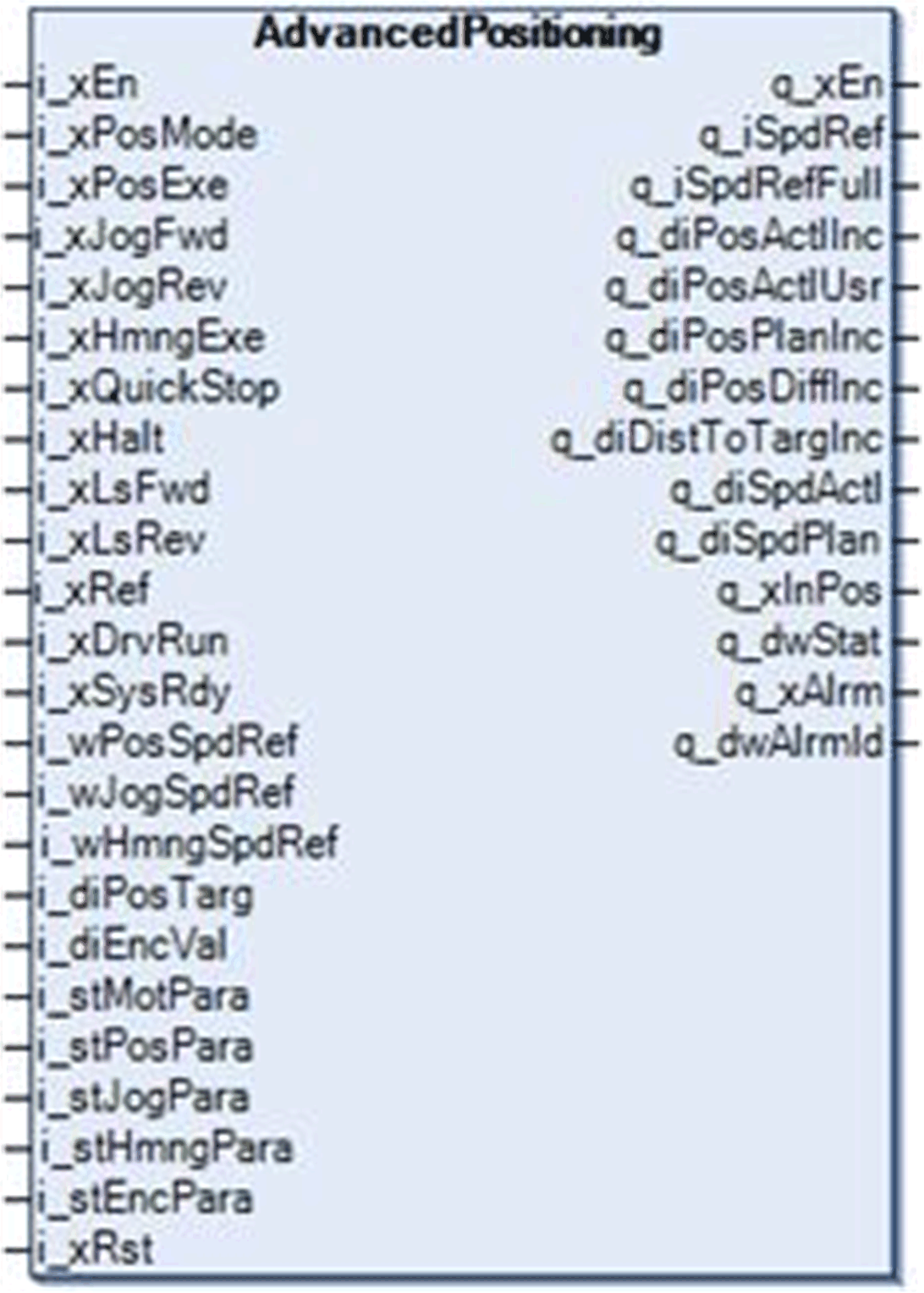AdvancedPositioning Function Block

The function block (FB) calculates a speed reference for variable speed drive. It contains a trapezoid speed profile generator and a position controller. Both ramping and speed reference calculations are handled by the FB. The variable speed drive must be configured to follow the speed reference given by the FB precisely. The FB supports absolute and relative movements.
Positioning is started by rising edge on i_xPosExe input.
Absolute movement:
oMovement to a pre-determined, fixed position of the axis.
oSupports change of the target position during execution (to prevent loss of position).
Relative movement:
oRelative change of axis position by a given distance.
oDoes not support change of travel distance during execution (to prevent loss of position).
The FB supports positioning of modulo axis.
This feature allows the following:
oPositioning of the axis in one direction without risk of overflow of internal position value. This is useful, for example, for positioning of conveyors.
oPositioning of rotational axis in positive, negative, and shortest distance directions.
oAbsolute and relative positioning within one modulo range or across multiple modulo ranges.
Position controller modifies the speed reference given to the drive in order to decrease the difference between the target position and the actual position. It corrects position difference both during movement and while the axis is at a standstill.
Position controller is active when the
ovariable speed drive is in RUN state,
osystem is ready, and
othe FB is not in an alarm state.
Position controller is not active when the
oFB was stopped using quick stop input,
oFB is in an alarm state, or
othe previous positioning task is not able to reach the target position.
Unit scaling allows scaling of the internal position value to user units. The absolute position of an axis is internally stored as a 32 bit integer value. For detailed description of unit scaling, refer to the description of the i_stEncPara structure.
An encoder or another device dedicated to position measurement is necessary for correct functioning of the FB. It supports both incremental and absolute encoders.
The FB works internally with a 32 bit position value. If the resolution of the position measurement device interface is less than 32 bit (16 bit for the internal encoder interface of Altivar drives, usually 25 bit for absolute encoders with a communication interface), the FB compensates for overflow of the encoder interface value up to the range of the internal 32 bit position.
|
|
|
UNINTENDED EQUIPMENT OPERATION |
|
Always verify that the value of the encoder position increases in a positive direction and decreases in a negative direction before putting the machine or process into operational service. |
|
Failure to follow these instructions can result in death, serious injury, or equipment damage. |
The FB supports various homing methods. It uses positive and negative limit switches or an optional reference position limit switch to define a home position.
For detailed description of homing methods, refer to the description of the i_stHmngPara structure. Homing is performed automatically (without movement of the axis) after the first download and after a change between linear and modulo mode.
Jog movement is designed to manually change a position of the axis. If configured (i_stJogPara.diJogDist>0), the axis performs a defined distance movement at a defined speed after a rising edge on a Jog command input (for example, one motor revolution). After this movement, the FB waits for a defined period (i_stJogPara.wJogDelay) and then, if the Jog command is still present, starts a continuous movement until the Jog command is set to FALSE or a limit switch is reached.
The FB supports limit switch signals for the definition of an operating area. It supports Normally Closed (N/C) limit switches. It does not support impulse limit switches, i.e., when the axis enters the area of the limit switch and beyond, the signal of the limit switch must remain FALSE.
Do not use positioning of linear axis without position limit switches.
|
|
|
UNINTENDED EQUIPMENT OPERATION |
|
oDo not use impulse or normally open contact switches in association with the function blocks. oOnly use Normally Closed contact switches with the function blocks. |
|
Failure to follow these instructions can result in death, serious injury, or equipment damage. |
NOTE: Limit switches are ignored in modulo mode.
Control of Variable Speed Drive
The FB generates a signed speed reference profile for variable speed drive. Setting the drive to RUN state must be handled by the user application outside of the AdvancedPositioning FB.
Motor Control Mode of the Drive
The positioning should be preferably used with drives running in closed loop motor control mode for better performance. However, it is still possible to position with a drive running in open loop motor control mode. For example, when the internal encoder interface of an Altivar drive that supports flux vector control is not used and an external position measurement is used for positioning, the positioning FB will still work, but the performance will be lower since the drive running in open loop does not follow its speed reference as accurately as in closed loop.